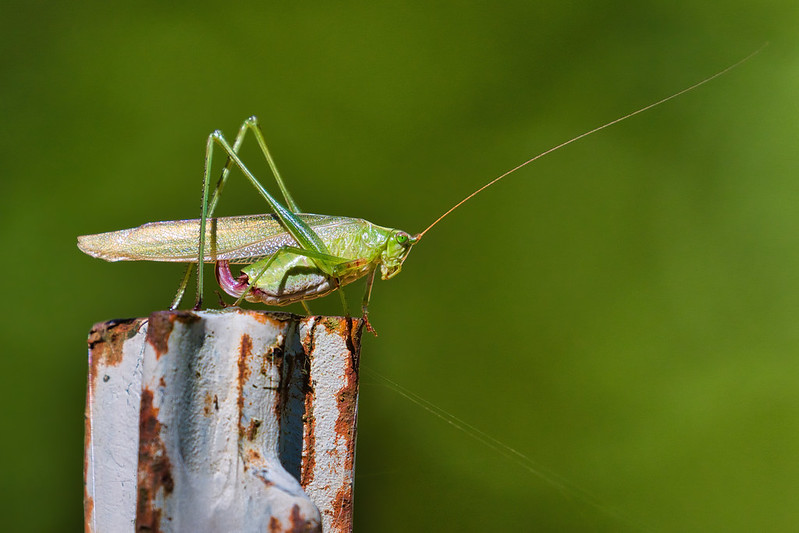While on a photo walk near my place here in Arkansas, I had the chance to observe one of nature’s most fascinating insects—the Katydid. These little creatures have always intrigued me, and spotting one on an old T-post is a moment worth sharing.

Katydids belong to the family Tettigoniidae, a group of insects renowned for their long antennae and distinctive songs. The name “Katydid” itself comes from the repetitive phrase “Katy did, Katy didn’t,” which perfectly captures the sound these insects make, especially on those warm summer nights. Their song is more than just a melody; it’s a mating call, with male Katydids rubbing their wings together to create a loud, repetitive trill. It’s a sound that, for me, is synonymous with summer.
These insects are part of the Orthoptera order, which includes crickets and grasshoppers. Given their similarities, it’s easy to mistake a Katydid for one of these relatives. However, Katydids can be distinguished by their incredibly long antennae—often longer than their entire body. This feature gives them a unique, almost whimsical appearance that sets them apart from their cricket and grasshopper cousins.
Katydids come in a variety of shapes, sizes, and colors, making each encounter with them a little different. The one I spotted was a beautiful green, blending seamlessly with the surrounding leaves. This camouflage is one of the Katydid’s greatest defenses, as many species have evolved to mimic leaves or branches, allowing them to hide in plain sight from predators. Some Katydids even sport brown or pink hues, adding to their ability to adapt to different environments.
In addition to their fascinating appearance and sound, Katydids play an essential role in our ecosystem. They feed on plants, including leaves, stems, and flowers, helping to control the growth of vegetation. This makes them a crucial part of the balance in nature, as they prevent certain plants from becoming too dominant. In turn, Katydids are a food source for a variety of predators, such as birds, reptiles, and bats, which rely on them for sustenance.
Spotting a Katydid during my walk was a reminder of the intricate and delicate balance that exists in nature. These small, seemingly insignificant insects contribute to the larger ecosystem in ways that are easy to overlook. As a wildlife photographer, moments like these are what fuel my passion for exploring the natural world. The Katydid’s song, its graceful antennae, and its role in the environment are all reminders of the beauty that surrounds us, even in the smallest of creatures.
So, the next time you hear that familiar “Katy did, Katy didn’t” on a summer evening, take a moment to appreciate the Katydid. These insects are not just background noise; they are an integral part of the natural symphony that makes our world so wonderfully diverse.
Steve Creek – Wildlife Photographer
